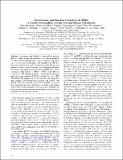Spontaneous and Selective Formation of HSNO, a Crucial Intermediate Linking H₂S and Nitroso Chemistries
Author(s)
Martin-Drumel, Marie-Aline; Lopez, Christopher A.; Crabtree, Kyle N.; Nguyen, Thanh L.; Thorwirth, Sven; Stanton, John F.; McCarthy, Michael C.; Nava, Matthew Jordan; Womack, Caroline C.; Cummins, Christopher C; ... Show more Show less
DownloadSpontaneous and selective formation of HSNO.pdf (381.2Kb)
PUBLISHER_POLICY
Publisher Policy
Article is made available in accordance with the publisher's policy and may be subject to US copyright law. Please refer to the publisher's site for terms of use.
Terms of use
Metadata
Show full item recordAbstract
Thionitrous acid (HSNO), a potential key intermediate in biological signaling pathways, has been proposed to link NO and H₂S biochemistries, but its existence and stability in vivo remain controversial. We establish that HSNO is spontaneously formed in high concentration when NO and H₂S gases are mixed at room temperature in the presence of metallic surfaces. Our measurements reveal that HSNO is formed by the reaction H₂S + N₂O₃ → HSNO + HNO₂, where N₂O₃ is a product of NO disproportionation. These studies also suggest that further reaction of HSNO with H₂S may form HNO and HSSH. The length of the S-N bond has been derived to high precision and is found to be unusually long: 1.84 Å, the longest S-N bond reported to date for an R-SNO compound. The present structural and, particularly, reactivity investigations of this elusive molecule provide a firm foundation to better understand its potential physiological chemistry and propensity to undergo S-N bond cleavage in vivo.
Date issued
2016-09Department
Massachusetts Institute of Technology. Department of ChemistryJournal
Journal of the American Chemical Society
Publisher
American Chemical Society (ACS)
Citation
Nava, Matthew, et al. “Spontaneous and Selective Formation of HSNO, a Crucial Intermediate Linking H₂S and Nitroso Chemistries.” Journal of the American Chemical Society 138, 36 (August 2016): 11441–11444 © 2016 American Chemical Society
Version: Author's final manuscript
ISSN
0002-7863
1520-5126